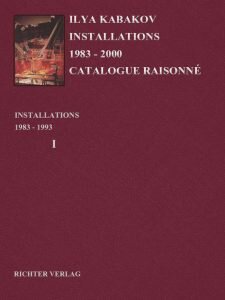The Collector
YEAR: 1988
CATALOGUE NUMBER: 20
NOTES
See Installations “Ten Characters,” (Cat No 15) and “The Reading Room,” (Cat No 90).
PROVENANCE
The artist
2000, Collection Lenbachhaus, Munich
EXHIBITIONS
New York, Ronald Feldman Fine Arts
Ten Characters. 30 Apr 1988 — 4 Jun 1988 (as part of No 15, Ten Characters)
London, Institute of Contemporary Art
Ilya Kabakov. The Untalented Artist and Other Characters at the ica London. 23 Feb 1989 — 23 Apr 1989 (as part of No 15, Ten Characters)
Zurich, Kunsthalle Zürich
Das Schiff – Die Kommunalwohnung, zwei Installationen von Ilya Kabakov. 2 Jun 1989 — 30 Jul 1989 (as part of No 15, Ten Characters)
Washington, Hirshhorn Museum and Sculpture Garden
Directions. Ilya Kabakov. Ten Characters. 7 Mar 1990 — 3 Jun 1990
Toronto, The Power Plant
Ilya Kabakov/John Scott. 15 Nov 1991 — 5 Jan 1992 (as part of No 15, Ten Characters)
Philadelphia, Institute of Contemporary Art
Face-off: The Portrait in Recent Art. 9 Sep 1994 — 30 Oct 1994
Joslyn Art Museum, Omaha
28 January – 19 March 1995
Weatherspoon Art Gallery, Greensboro
9 April – 28 May 1995
Paris
Le Collectionneur. 19 May 1995 — 13 Jul 1995
Hamburg, Deichtorhallen
Ilya Kabakov. Der Lesesaal – Bilder, Leporellos und Zeichnungen. 19 Apr 1996 — 28 Jul 1996
Seattle, Henry Art Gallery
Inside. 13 Apr 1997 — 29 Jun 1997
Salzburg, Galerie Thaddaeus Ropac
The Collector. 4 Apr 1998 — 15 May 1998
ARTIST`S COMMENTS
… Complete loneliness – you are alone, there is no one around you, the lamp illuminates the surface of the table you are sitting at. You are immersed in what you are doing: you are gluing postcards on carefully cut out small pieces of wrapping paper in a special order that you have devised. On the postcards, there are views of the sea, landscapes, people in strange white hats, paintings from the Tretyakov Gallery. Time stopped and then it began again in conformity with the rhythm of gluing, arranging in a pile to the left the sheets that are ready. The distant, exciting world, unaware of you and living its own life, approaches, it becomes small, yours. This is almost the same as gluing stamps into a ‘stamp’ album. But something entirely different emerges while gluing postcards: a strong, bright stream of joy of which there is so little, virtually none at all in the life that surrounds you. You disappear, float away into another space, into another world where you haven’t been and probably never will be – a place where they dance, sing. A blue lake is surrounded by blue mountains, someone is riding around the infinite steppe on a short horse. Having raised your eyes, you see the walls of the room, slightly illuminated by the lamp, and you understand with anguish that there is no connection at all between the shining images on the postcards and the place where you spend your time day after day … There is no crossover, no bridge, between that large, wonderful and distant world and this pitiful small one of yours. Of course, you could read, read one travel book after another, until oblivion, submerging yourself via imagination into the world depicted there, float on the waves of the story that is skillfully unfolded before you by the writer. But a terrible thing happens after you finish reading: a terrible feeling, that this was a dream, that the same walls surround you and nothing has changed around you. You convulsively search, grab another book, a third, in order only to close this gaping interval that is before you…
But this bridge, this fantastic crossover to the other shining, inaccessible shore, does, in fact, exist when you place in front of you the stack of carefully cut-out pieces of gray paper. The pages are blank, gray and just as depressing as everything around you. But you place a jar of glue and a brush next to it. A miracle occurs. The postcards which you bought in the store next door and the pieces cut out of magazines are glued in the order which you think up yourself: according to the topic, color, size. You are in charge and manage this paper world, and it smoothly and imperceptibly becomes yours, crosses over into yours at the moment of gluing. Numerous different worlds land like butterflies and are attached to your pag… There aren’t enough pages for the glue-ons, and so you make use of old journals with color illustrations that have already been read, and this is even better. The postcards are glued directly onto these pages and what results is even more interesting: worlds depart into the depths like galaxies in the cosmos, emerging and hiding, covering one another, peeking out from behind one another…
Images
Literature







